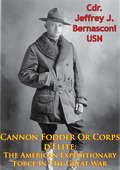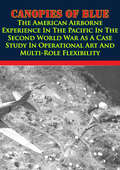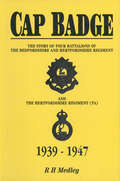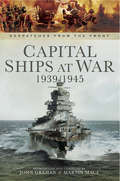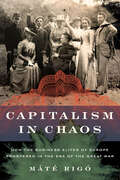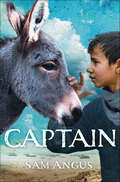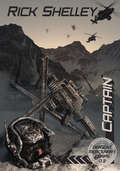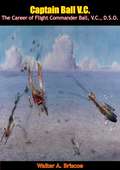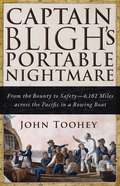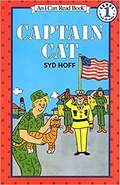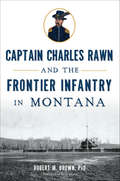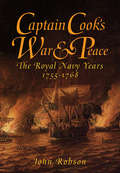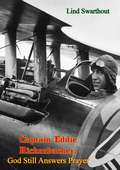- Table View
- List View
Cannon Fodder Or Corps d'Elite: The American Expeditionary Force In The Great War [Illustrated Edition]
by Cdr. Jeffrey J. BernasconiIncludes The Americans in the First World War Illustration Pack - 57 photos/illustrations and 10 mapsThe analysis of the impact of the American Expeditionary Force (AEF) in the Great War has fallen into two competing camps. The first believes that the AEF was the war winning factor in coalition warfare. The opposite view holds that the AEF itself had no true impact, but rather it was the industrial might and the manpower potential of the United States (US) that was the key element to victory. The caveat to both views was that the AEF did not have enough time in combat to truly show its martial ability. This thesis attempts to analyze the combat effectiveness of the AEF by comparing its experience with that of the British Expeditionary Force (BEF) in 1916. The rate of change in the ability of the AEF to adapt to modern warfare will be shown to be slightly higher than that of the BEF of 1916. By November 1918, the AEF was not completely tactically combat effective, but it had dramatically improved from where it started and clearly demonstrated the potential to continue to improve at the same pace.
Canopies Of Blue: The U.S. Airborne Experience In The Pacific In WWII As A Case Study In Operational Art And Multi-Role Flexibility
by Major Channing M. Greene Jr.As America's collective memory of the Second World War fades, popular history books and the entertainment industry have filled the knowledge gap with accounts from the European Theater. A resurgence in works focusing on the war in the Pacific has surfaced in recent years, but the topic still requires a fresh perspective. In particular, the American airborne experience in the Pacific presents a field ripe for exploration.This historical monograph argues that a careful review of the operations involving the 11th Airborne Division, the 503rd Parachute Infantry Regiment, and the 1st Marine Parachute Battalion reveals a measure of foresight on the part of those who designed campaign plans in the Pacific. General Joseph Swing's implementation of the Paraglider concept in the 11th Airborne enabled his unit to perform a variety of tasks including amphibious operations, parachute drops, and POW camp raids. The Allies' only independent parachute regiment in the Pacific, the 503rd, successfully employed the combined arms concept in its capture of Nadzab and set the conditions for the Allied reduction of Japanese defenses around Rabaul. The United States Marine Corps' short-lived experiment with airborne forces revealed the usefulness of units in multi-role functions, but ultimately betrayed an inability to execute actual parachute drops because of logistical limitations in the ocean environment.
Canterbury in the Great War (Your Towns & Cities in the Great War)
by Stephen WynnA historic profile of the English city of Canterbury during World War I and the conflict&’s effect on the region and its people. Canterbury had been a garrison town for many years before the war. When hostilities began between Britain and Germany, it was home to the Buffs (East Kent Regiment), who were immediately mobilized for war. They were replaced by the men of the West Kent Yeomanry, a Territorial unit, along with their fellow territorials, the Kent Cyclists, who despite their mode of transport, were an infantry battalion of the British Army, who were formed in 1908. They were tasked with guarding key points along with patrolling the Kent coastline. During the First World War, Canterbury was one of the county&’s main recruiting areas, particularly for those men from east Kent. By the end of the war, thousands of men had enthusiastically made their way to the town&’s Drill Hall in St Peter's Lane to sign on the dotted line so that they could do their bit for King and country in the nation&’s hour of need. Statistics showed that one in four men had enlisted in the British Army. Meanwhile, the town&’s civilian population did their part for the war. Some worked in the munitions factories and the Kent VAD hospital, while others worked as air raid wardens. These were extraordinary times that relied on ordinary people to pull together and do whatever they could for the common good. Through researching local newspapers of the day, along with letters, diaries, photographs, parish magazines, trade journals, contemporary printed pamphlets, and more, author Stephen Wynn details the stories of this dramatic era.
Canto a Darley Dene
by Stuart G. Yates Rocio Belén SileoBasado en hechos reales. Después de la Segunda Guerra Mundial, el joven Ben descubre una historia extraña. Durante el Blitz de 1941, decenas de soldados murieron en el mismo sitio donde se ubica hoy su patio de juegos. Eventos terribles del pasado vuelven al presente y, mientras unos secretos antiguos y otras verdades ocultas salen a la luz poco a poco, Ben se ve atrapado en una serie de incidentes raros e inexplicables. Esta es una historia sobre descubrimiento personal y superación de los miedos, dado que aquello enterrado bajo tierra es verdaderamente espeluznante. Ben está a punto de develar los secretos de su familia, y para eso tendrá que ayudar a que los horrores en la memoria de Darley Dene descansen en paz.
Cap Badge: The Story of Four Battalions of The Bedfordshire and Hertfordshire Regiment and the Hertfordshire Regiment (TA) 1939–1947
by R. H. MedleyThe backbone of the British Army has always been the County regiments. This is an account of a typical British regiment from Dunkirk to 1947.
Capabilities-Based Planning for Energy Security at Department of Defense Installations
by Henry H. Willis Constantine SamarasDepartment of Defense (DoD) installations rely on the commercial electricity grid for 99 percent of their electricity needs, but the U. S. electricity grid is vulnerable to disruption from natural hazards and actor-induced outages, such as physical or cyber attacks. Using portfolio analysis methods for assessing capability options, this paper presents a framework to evaluate choices among energy security strategies for DoD installations.
Capability Planning and Analysis to Optimize Air Force Intelligence, Surveillance, and Reconnaissance Investments
by National Research Council Division on Engineering and Physical Sciences Committee on Examination of the Air Force Intelligence, Surveillance, and Reconnaissance (ISR) Capability Planning and Analysis (CPA&A) Process Air Force Studies BoardIntelligence, surveillance, and reconnaissance (ISR) capabilities have expanded situation awareness for U.S. forces, provided for more precise combat effects, and enabled better decision making both during conflicts and in peacetime, and reliance on ISR capabilities is expected to increase in the future. ISR capabilities are critical to 3 of the 12 Service Core Functions of the U.S. Air Force: namely, Global Integrated ISR (GIISR) and the ISR components of Cyberspace Superiority and Space Superiority, and contribute to all others. In response to a request from the Air Force for ISR and the Deputy Assistant Secretary of the Air Force for Science, Technology, and Engineering, the National Research Council formed the Committee on Examination of the Air Force Intelligence, Surveillance, and Reconnaissance (ISR) Capability Planning and Analysis (CP&A) Process. In this report, the committee reviews the current approach to the Air Force corporate planning and programming process for ISR capability generation; examines carious analytical methods, processes, and models for large-scale, complex domains like ISR; and identifies the best practices for the Air Force. In Capability Planning and Analysis to Optimize Air Force Intelligence, Surveillance, and Reconnaissance Investments, the current approach is analyzed and the best practices for the Air Force corporate planning and programming processed for ISR are recommended. This report also recommends improvements and changes to existing analytical tools, methods, roles and responsibilities, and organization and management that would be required to ensure the Air Force corporate planning and programming process for ISR is successful in addressing all Joint, National, and Coalition partner's needs.
Capability Surprise for U.S. Naval Forces: Interim Report
by Committee on Capability Surprise for U.S. Naval ForcesA letter dated December 21, 2011, to National Academy of Sciences President Dr. Ralph Cicerone from the Chief of Naval Operations, ADM Jonathan W. Greenert, U.S. Navy, requested that the National Research Council's (NRC's) Naval Studies Board (NSB) conduct a study to examine the issues surrounding capability surprise-both operationally and technically related-facing the U.S. naval services. <P><P>Accordingly, in February 2012, the NRC, under the auspices of its NSB, established the Committee on Capability Surprise for U.S. Naval Forces. The study's terms of reference, provided in Enclosure A of this interim report, were formulated by the Office of the Chief of Naval Operations (CNO) in consultation with the NSB chair and director. The terms of reference charge the committee to produce two reports over a 15-month period. The present report is the first of these, an interim report issued, as requested, following the third full committee meeting.
Capital Offensive
by Don PendletonSTONY MAN. Dedicated to a seek-and-destroy mandate when presidential directive sends them into the heat of battle, the cyber and commando teams of Stony Man hit hard and fast to remove threats of global magnitude. Now a secret terrorist organization has hacked its way into defense satellites--opening a trapdoor to Hell. . . CAPITAL OFFENSIVE. America stands virtually defenseless as global security is compromised and nations prepare for the final conflagration that will end civilization. Stony Man gets a lead on a rogue Argentinean general and his twisted vision of a scorched and reborn planet Earth, but tracking the technology and the masters of destruction is a race where seconds count. . . and the loser will be humanity itself.
Capital Ships at War, 1939–1945 (Despatches From The Front Ser.)
by Martin Mace John GrehanDispatches in this volume include those relating to the sinking of the German battleship Graf Spee in the Battle of the River Plate in 1939, the loss of the battleships HMS Prince of Wales and HMS Repulse in the Far East, the sinking of the German battle cruiser Scharnhorst in 1943, the attack on Tirpitz by midget submarines, the contribution by British Pacific Fleet to the assault on Okinawa in 1945 (which included four Royal Navy battleships), and the sinking of Bismarck in 1941.This unique collection of original documents will prove to be an invaluable resource for historians, students and all those interested in what was one of the most significant periods in British military history.
Capitalism and American Leadership
by Oliver C CoxExplore the intricate dynamics of economic power and political influence with Oliver C. Cox's seminal work, Capitalism and American Leadership. This thought-provoking book delves into the critical relationship between capitalism and the leadership structures that have shaped the United States, offering a profound analysis of how economic forces drive political and social change.Cox, a distinguished sociologist, examines the historical development of American capitalism and its impact on leadership and governance. Through a rigorous exploration of economic policies, corporate strategies, and political maneuvers, the book unveils the complex interplay between wealth and power. Cox's insightful analysis illuminates the mechanisms through which capitalistic systems have influenced American leadership, from the early industrial age to the contemporary era.Capitalism and American Leadership goes beyond mere economic theory, addressing the broader implications of capitalist practices on societal structures and individual lives. Cox critically assesses the consequences of capitalism on social equality, democracy, and global leadership, providing readers with a nuanced understanding of the benefits and challenges inherent in the capitalist model.Rich with historical context and sociological insight, Cox's work challenges readers to rethink their perspectives on economic power and its role in shaping political leadership. Capitalism and American Leadership is an essential read for scholars, students, policymakers, and anyone interested in the forces that drive American society and its leadership.Through compelling arguments and comprehensive research, Oliver C. Cox offers a timeless exploration of the foundational principles of capitalism and its enduring influence on American leadership. This book is a vital addition to the discourse on economic theory, political science, and the future of governance in a rapidly changing world.
Capitalism in Chaos: How the Business Elites of Europe Prospered in the Era of the Great War
by Máté RigóCapitalism in Chaos explores an often-overlooked consequence and paradox of the First World War—the prosperity of business elites and bankers in service of the war effort during the destruction of capital and wealth by belligerent armies. This study of business life amid war and massive geopolitical changes follows industrialists and policymakers in Central Europe as the region became crucially important for German and subsequently French plans of economic and geopolitical expansion in the late nineteenth and early twentieth centuries. Based on extensive research in sixteen archives, five languages, and four states, Máté Rigó demonstrates that wartime destruction and the birth of "war millionaires" were two sides of the same coin. Despite the recent centenaries of the Great War and the Versailles peace treaties, knowledge of the overall impact of war and border changes on business life remains sporadic, based on scant statistics and misleading national foci. Consequently, most histories remain wedded to the viewpoint of national governments and commercial connections across national borders.Capitalism in Chaos changes the static historical perspective by presenting Europe's East as the economic engine of the continent. Rigó accomplishes this paradigm shift by focusing on both supranational regions—including East-Central and Western Europe—as well as the eastern and western peripheries of Central Europe, Alsace-Lorraine and Transylvania, from the 1870s until the 1920s. As a result, Capitalism in Chaos offers a concrete, lively history of economics during major world crises, with a contemporary consciousness toward inequality and disparity during a time of collapse.
Caporetto 1917: Victory or Defeat? (Military History and Policy)
by Mario MorselliThis work concerns the Battle of Caporetto in October 1917, where the Austro-German Army broke through the Italian lines forcing them to retreat after losing half their force. The book examines why, having routed the Italian Army, the Central Alliance forces were not capable of forcing the surrender of Italy.
Captain
by Sam AngusIt's 1915 and British troops are about to sail to Gallipoli. Billy is the youngest soldier in his platoon and is teased for not being old enough to drink or shave. The truth is, at fifteen he's not old enough to be a soldier, either, and he's terrified of the war he's about to fight. Then he meets Captain, a refugee boy, and his donkey, Hey-ho. Together they teach Billy what it means to be brave, loyal, and fearless, and above all what it means to be a friend.Sam Angus pulls at heartstrings in this stirring wartime friendship story.
Captain (Dirigent Mercenary Corps #3)
by Rick ShelleyA disgraced soldier seeks redemption in a pulse-pounding military science fiction thriller from the national bestselling author of the Special Ops Squad.The year is 2804 AD. Humanity has colonized the universe. But the authority of the Confederation of Human Worlds is spread thin. Where the Army of planet Earth cannot reach, mercenaries must keep the peace—and the Dirigent Mercenary Corps are the best of the best.Serving with the Dirigent Mercenary Corps wasn’t Lt. Lon Nolan’s first choice—it was his only choice. After he was expelled from the North American Military Academy, there was nowhere else to go. He’s finally made a place for himself with the DMC when a girl has to go and throw a wrench in his plans. Sara Pines is beautiful and brilliant, and he’s sure she’s the one.Unfortunately, Lon’s shipped out to quell a civil war on a distant planet before he has a chance to marry the woman he loves. And now that he’s arrived on Aldrin, it’s becoming increasingly clear that he might never make it home . . .“Rick Shelley was a soldier at heart, and his books were written from the heart. They carry the real feel of the sweat, blood, and camaraderie of those on the front lines.” —Jack Campbell, New York Times–bestselling author
Captain Amberton's Inherited Bride (Mills And Boon Historical Ser.)
by Jenni Fletcher“Marry me…and you’ll have your freedom.”Her father’s will dictates Violet Harper must wed or be disinherited—yet she’d rather face the wilderness of the wintry Yorkshire moors than be bound to cynical, damaged soldier Captain Lance Amberton. Lance promises a marriage of convenience that will grant Violet her independence. In exchange, she must put her faith in Lance and see beyond his gruff exterior to the man beneath…“Fletcher has crafted a romance to engage medievalists” — RT Book Reviews on Besieged and Betrothed “Medieval fans will love the pageantry, the original setting and the surprises at every turn.” — RT Book Reviews on Married to Her Enemy
Captain Ball V.C.: The Career of Flight Commander Ball, V.C., D.S.O.
by Walter A. BriscoeFirst published in 1918, this is the seminal biography of World War I’s “best English flying man”, Captain Albert Ball. This volume contains a reprint of a collection of personal letters written by Captain Ball and is illustrated throughout with black and white photographs.Albert Ball, VC, DSO & Two Bars, MC (14 August 1896 - 7 May 1917) was an English fighter pilot during WWI. At the time of his death he was the United Kingdom’s leading flying ace, with 44 victories, and remained its fourth-highest scorer behind Edward Mannock, James McCudden, and George McElroy.Born and raised in Nottingham, Ball joined the Sherwood Foresters at the outbreak of WWI and was commissioned as a second lieutenant in October 1914. He transferred to the Royal Flying Corps (RFC) the following year, and gained his pilot’s wings in 1916. Joining No. 13 Squadron RFC in France, he flew reconnaissance missions before being posted in May to No. 11 Squadron, a fighter unit. From then until his return to England on leave in October, he accrued many aerial victories, earning two Distinguished Service Orders and the Military Cross. He was the first ace to become a British national hero.After a period on home establishment, Ball was posted to No. 56 Squadron, which deployed to the Western Front in April 1917. He crashed to his death in a field in France on 7 May, sparking a wave of national mourning and posthumous recognition, which included the award of the Victoria Cross for his actions during his final tour of duty.“I am sure nobody can read these letters without feeling that it is men like Captain Ball who are the true soldiers of British democracy. It is their spirit of fearless activity for the right, in their daily work, which will lead us through victory into a new world in which tyranny and oppression will have no part.”—D. LLOYD GEORGE, Foreword
Captain Blackman: A Novel
by John A. WilliamsA &“fascinating novel&” of race and war in historical US conflicts—through the eyes of a black soldier inexplicably traveling through time (The New York Times Book Review). In the midst of the racial tensions in the army during the Vietnam War, Capt. Abraham Blackman does what he can to educate his fellow black soldiers on the history of race relations in the US military. But when he is gravely wounded in the jungle of Southeast Asia, he finds himself inexplicably rocketed into those conflicts of the past. From slavery to segregation, Blackman experiences firsthand the racism—from subtle and insidious discrimination to outright violence—of the American military&’s past. Yet no matter the conflict, be it the Revolutionary War, the Civil War, or World War II, Blackman fights for a racist military establishment that expects black soldiers to die for the cause of &“freedom&”—even when they are denied it at home. Ultimately, Blackman&’s greatest challenge will take place in his own time, in Vietnam, where he must battle not only to survive but for that most elusive of victories: justice. This &“necessary [and] boldly experimental&” historical novel from the two-time American Book Award–winning author brilliantly explores the complicated legacy of the African American soldier throughout US history (The New York Times Book Review).
Captain Bligh's Portable Nightmare: From the Bounty to Safety—4,162 Miles across the Pacific in a Rowing Boat
by John TooheyAt dawn on April 28, 1789, Captain William Bligh and eighteen men from HMS Bounty were herded onto a twenty-three-foot launch and abandoned in the middle of the Pacific Ocean. Thus began their extraordinary journey to Java. Covering 4,162 miles, the small boat was battered by continuous storms, and the men on board suffered crippling illness, near starvation, and attacks by islanders. The journey was one of the greatest achievements in the history of European seafaring and a personal triumph for a man who has been misjudged by history.Captain Bligh's Portable Nightmare reveals Bligh?s great mapmaking skills, used to particular effect while he was exploring with Captain Cook. We discover his guilt over Cook's death at Kealakekua Bay. We learn of the failure of the Bounty expedition and the myths that surround the mutiny led by Lieutenant Fletcher Christian, the trials and retributions that followed Bligh's return to England, his successes as a navigator and as a vice admiral fighting next to Nelson at the Battle of Copenhagen. Combining extensive research with dazzling storytelling, John Toohey tells a gripping tale of seafaring, exploration, and mutiny on the high seas, while also dismissing the black legend of the cruel and foulmouthed Captain William Bligh and reinstating him not just as a man of his times but as a true hero.
Captain Cat: Story And Pictures (I Can Read Level 1)
by Syd HoffA cat befriends a soldier and learns about military life when he joins the army.
Captain Charles Rawn and the Frontier Infantry in Montana (Military)
by Robert M. BrownStationed in Montana during the height of the Indian Wars, Captain Charles Rawn proved an unlikely hero and an indispensable leader in numerous battles. He took command from a drunken Major Baker at the Battle of Pryor's Creek, saving the 400 soldiers from possible annihilation at the hands of 1,000 Sioux. As commander of Fort Missoula, he led 35 soldiers and 200 volunteers in an attempt to halt 850 Nez Perce warriors. When Colonel Gibbon suffered an injury at the Battle of the Big Hole, Rawn's experience and leadership of the 7th Infantry helped prevent another Custer debacle. Author Robert M. Brown catalogues the career of this outstanding officer and the transformation of the frontier army from a Civil War legacy into an elite fighting force.
Captain Cook
by Vanessa CollingridgeA uniquely woven story encompassing three separate centuries and three different lives. Captain Cook, best known for his heroic voyages through the Pacific Ocean, is brought to life in vivid detail. We follow his humble beginnings as the son of a farm labourer, through his convention-shattering treatment of the indigenous groups he met on his travels, and then onto his final tragic voyage which signalled the end of his revered reputation. One hundred years on from the death of Cook, another great man, George Collingridge begins his own adventure. He, like Cook was oblivious to the implications his journey would have. Along the way he unfolds ancient maps, secret tales and unearths hidden lands and buried treasure. He is also said to have realised that it was not Cook who discovered Australia - it was the Portugese. This firm belief was the eventual cause of his self-destruction.Another hundred years later Vanessa Collingridge, is searching for books on her lifelong hero Captain Cook in a university library. She discovers the name of a distant cousin, George Collingridge, in a dusty card index. And so a new journey of discovery begins - in the footsteps of her hero and his nemesis.
Captain Cook's Merchant Ships: Freelove, Three Brothers, Mary, Friendship, Endeavour, Adventure, Resolution and Discovery
by Stephen BainesWhile the story of Endeavour is widely written about, Captain Cook sailed in or with eight ships which began their lives as merchant ships. This detailed illustrated history tells the story of these ships and the people who sailed in them. In placing these ships and people in the personal, political, social, financial, scientific and religious contexts of their times, this book provides a readable and comprehensible account of the long Eighteenth Century. Often using contemporary sources, this gripping account fills a gap in Cook history and attempts to catch something of that exciting, violent, gossipy but largely untaught and unknown period through which these vessels and their people sailed literally and figuratively between the old world and the new.
Captain Cook's War & Peace: The Royal Navy Years, 1755–1768
by John RobsonWhy was James Cook chosen to lead the Endeavour expedition to the Pacific in 1768? As this new book shows, by that date he had become supremely and uniquely qualified for the exacting tasks of exploration.This was a period when who you were and who you knew counted for more than ability, but Cook, through his own skills and application, rose up through the ranks of the Navy to become a remarkable seaman to whom men of influence took notice; Generals such as Wolfe and politicians like Lord Egmont took his advice and recognised his qualities.During this period Cook added surveying, astronomical and cartographic skills to those of seamanship and navigation. He was in the thick of the action at the siege of Quebec during the Seven Years War, was the master of 400 men, and learned at first hand the need for healthy crews. By 1768 Cook was supremely qualified to captain Endeavour and a reader might ask, 'why would you choose anyone else but Cook to lead such a voyage.'Highly readable and displaying much new research, this is an important new book for Cook scholars and armchair explorers alike.
Captain Eddie Rickenbacker: God Still Answers Prayer
by Lind SwarthoutHe was called America's Ace of Aces during World War I, the highest scorer of American aerial victories over the Germans. He could just as easily have been labeled the "luckiest man alive," however, since he survived-by his own count-135 brushes with death during his exciting lifetime. In this fascinating biography, Lind Swarthout traces the life of Eddie Rickenbacker, who at the time of writing had just been rescued from 24 days adrift at sea sustained by an indomitable spirit and unshakeable faith in God.
